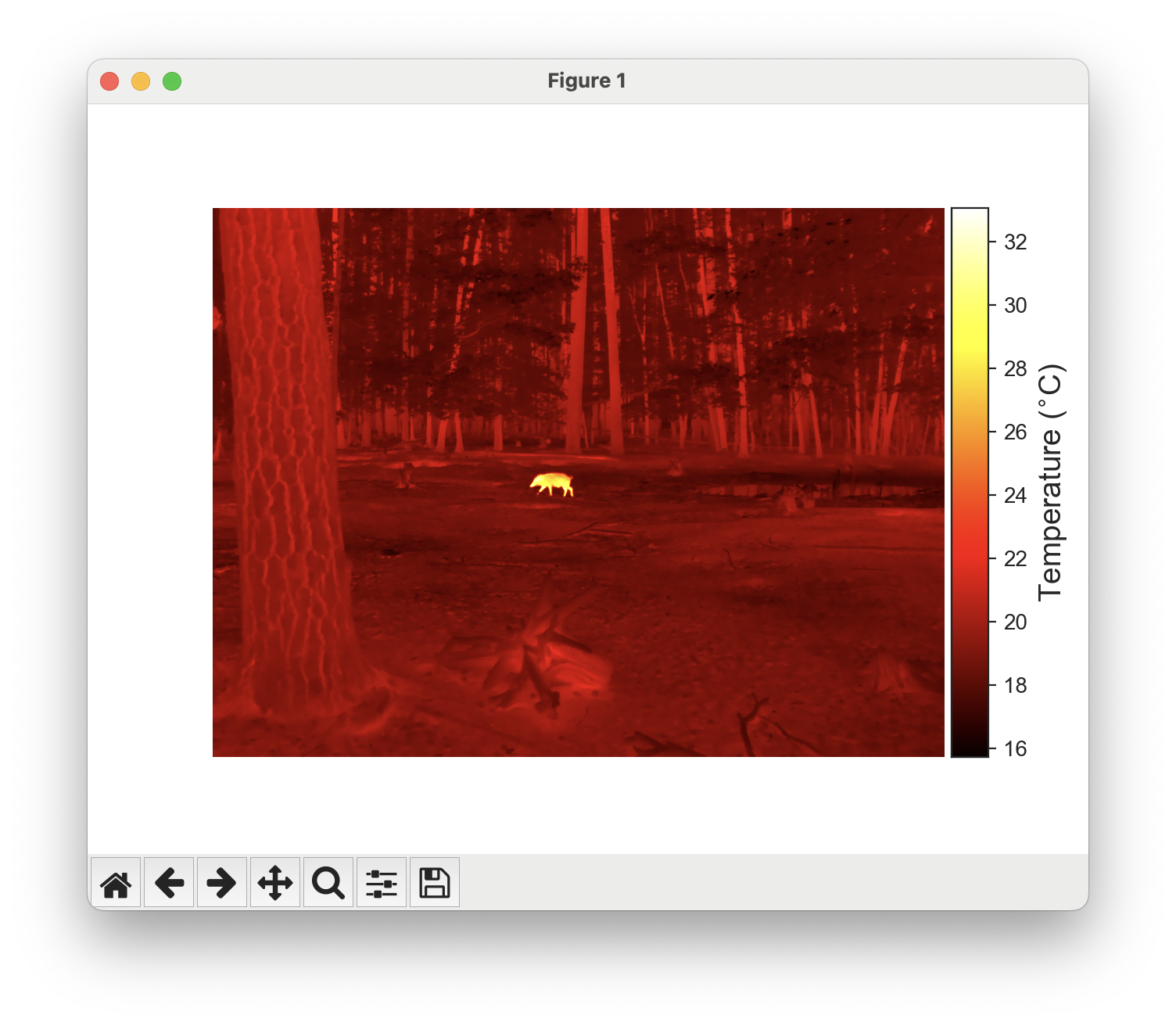This repository provides a way for thermal videos acquired by a FLIR camera to be read in Python.
The .csq file format stores each image in the thermal video in 16-bit binary form. The image itself is encoded in the JPEG-LS standard and decoded with the libjpeg library.
Using some calibration constants from the thermal camera which are read using exiftool, the temperature data can be calculated, allowing the image to be expressed in degrees Celcius. With this repository, you can directly obtain the temperature values without having to worry about this conversion!
You need to have exiftool installed on your system.
pip install -r requirements.txt
Here I will use an example thermal video to show you how to use this repository. If you would like to follow along, you can download hog.csq from this Google Drive link.
First, import the module and construct a CSQReader object from the path to hog.csq:
from csq import CSQReader
path = '~/Downloads/hog.csq'
reader = CSQReader(path)To read a frame of the video, you can use the next_frame() function. Let's read and plot the first frame:
import seaborn as sns
import matplotlib.pyplot as plt
from mpl_toolkits.axes_grid1 import make_axes_locatable
def plot_thermal(frame):
sns.set_style('ticks')
fig = plt.figure()
ax = plt.gca()
im = plt.imshow(frame, cmap = 'hot')
divider = make_axes_locatable(ax)
cax = divider.append_axes("right", size="5%", pad=0.05)
cbar = plt.colorbar(im, cax = cax)
cbar.ax.set_ylabel('Temperature ($^{\circ}$C)', fontsize = 14)
sns.despine()
plt.show()
frame = reader.next_frame()
plot_thermal(frame)When analyzing thermal imaging data, you may want to perform a certain operation on each frame. For example, maybe you want to extract the maximum temperature at each frame in the video. To determine this, you can simply create a loop to continuously call the next_frame() function:
import numpy as np
max_temps = []
while reader.next_frame() is not None:
frame = reader.next_frame()
max_temps.append(np.max(frame))
# other operations for current frameHowever, there may be cases when you only need to extract thermal data from only certain frames within a video. For faster processing, you can use the frame_at() function to get the thermal data from a specific frame. Perhaps we only want to plot the 200th frame:
frame = reader.frame_at(200)
plot_thermal(frame)If you want to know how many frames a video has you can use the count_frames() function, it returns the number of frames as interger.
print(reader.count_frames())There are some examples of use cases for exporting the CSQ files in different means in the examples directory.
If you want to export all frames of a CSQ file as individual files automatically. An full example is also located in the examples directory of this repo.
def export_thermal_image(frame, name: str):
filen_name = output + name + ".png"
hot = plt.cm.hot
norm = plt.Normalize(vmin=frame.min(), vmax=frame.max())
image = hot(norm(frame))
plt.imsave(filen_name, image)
i = 0
reader._populate_list()
for frame in reader.frames():
export_thermal_image(frame, name="filename_" + str(i))
i += 1The export_as_video.py file located in the examples directory can be used to export a CSQ as a video file. It has a flag to set the framerate of the video, the default is 30 fps.
$ python3 examples/export_as_video.py -i example.csq -o output.mp4 --fps 30This examples exports a CSQ file as video files with different thermal filters. The first argument needs to be the input CSQ file and the second one an output directory.
$ python3 examples/export_as_video_all_filters.py example.csq ./example/directory/To use the AI upscaling feature you have to download a tensorflow model from one of theses sources and edit the export_as_video.py file as well as setting the --upscale_video flag to true.
- https://github.com/Saafke/EDSR_Tensorflow/tree/master/models
- https://github.com/fannymonori/TF-LapSRN/tree/master/export
This project was inspired by the Thermimage package, which allows for FLIR thermal image analysis in R:
Glenn J. Tattersall. (2017, December 3). Thermimage: Thermal Image Analysis. doi: 10.5281/zenodo.1069704 (URL:http://doi.org/10.5281/zenodo.1069704), R package, <URL:https://CRAN.R-project.org/package=Thermimage>.
